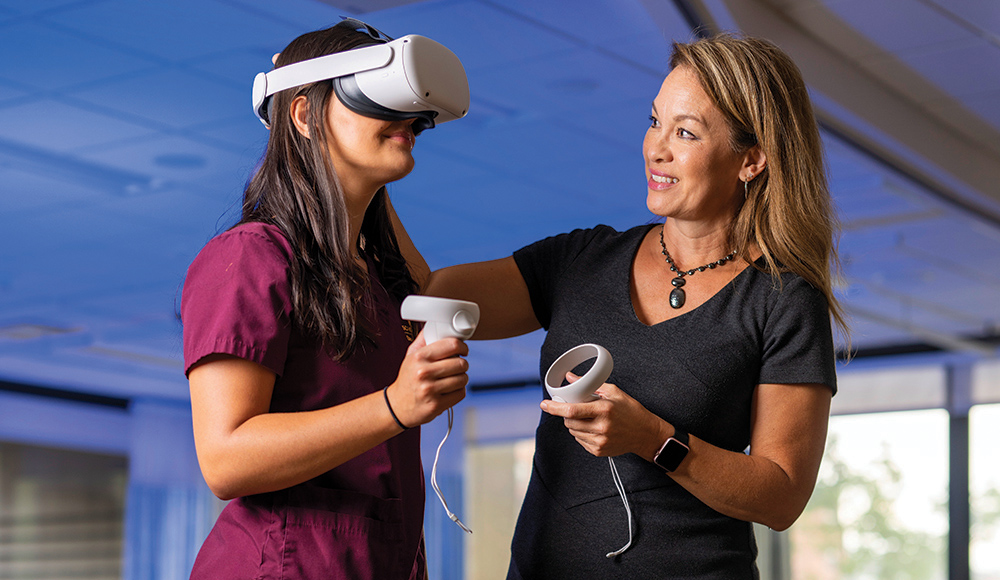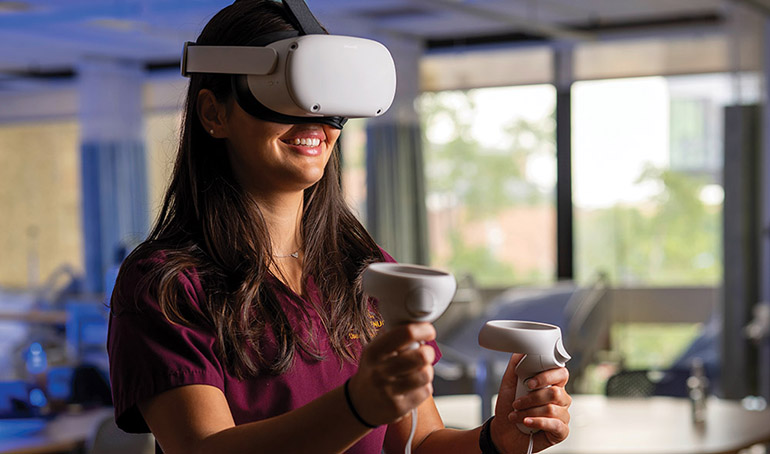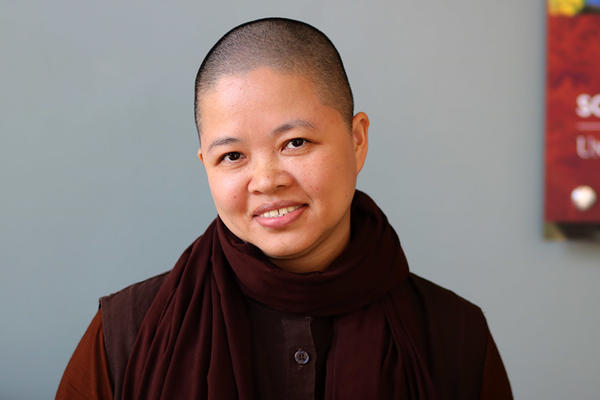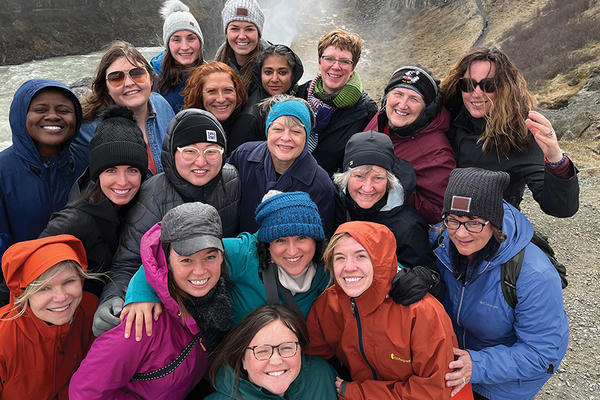Reimagining nursing education
Cynthia Bradley awarded $1.3 million American Nurses Foundation grant to pilot immersive virtual reality, structured clinical preceptorship
October 25, 2022
Steve Rudolph

BSN student Maura Talwalkar practices using an Oculus headset and controllers.
What more can be done to better prepare nursing students for practice?
Are there strategies a nursing school can implement to reduce the time their graduates need to onboard in the workplace? Can adding experiences in nursing curricula prevent burnout and turnover in nursing?
These are some of the questions Assistant Professor Cynthia Bradley, PhD, RN, CNE, CHSE, wrestles with as director of simulation at the School of Nursing. She’s hoping a three-year pilot that uses immersive virtual reality (VR) simulation coordinated with a structured clinical preceptorship and reflective debriefing will provide some of the answers.
Bradley is leading the Big 10 Practice-Ready Nursing Initiative, a partnership with the University of Michigan School of Nursing and Purdue University School of Nursing. Bradley was awarded a $1.3 million grant from the American Nurses Foundation Reimagining Nursing Initiative. The project was one of 10 bold ideas, selected from more than 350 nurse-led projects under consideration to transform the education, regulation and practice of nursing.
The research team is collaborating with Oxford Medical Simulation, a global leader in the VR industry, to develop five learning modules that will be used with an Oculus headset. Two modules have already been developed with three additional modules to be added in the spring.
Better preparing nursing students for the workforce
A key component the researchers hope VR will add to nursing education is better preparation for students in caring for multiple patients, which more realistically represents current nursing practice. Two patients are typically the most a student nurse will care for during their education, yet early in their professional careers nurses are expected to care for a full caseload of patients. Adding more patients for students in their clinical experiences is not always feasible. Moreover, challenges with adequate space, expensive manikins and availability of standardized patients makes it nearly impossible to do multiple patient scenarios in simulation centers, which are already stretched to capacity.

“As a caseload of patients increases, how do students learn how to prioritize care? How do they know what to do first and with which patient?” asks Bradley. “We believe that in the virtual environment the student will be able to practice and master those skills, starting with one or two patients and increasing to a caseload of five. They’ll have more time to practice in a safe space without risking patient safety, while also gaining confidence and competence. Most importantly, they’ll be able to practice decision-making skills.”
To evaluate effectiveness of the pilot, the team will use a clinical competency tool to assess how students navigate the virtual environment as well as in the clinical environment at several time points during the first two years of the study. Bradley is recruiting two additional Big 10 schools to test if the VR learning process can be replicated in other nursing programs during the third year of the project.
Expanding access to quality simulation
Throughout her career, Bradley has consulted with nursing schools on the use of simulation. In that time she has seen many programs that have the funding to buy manikins but not funding for training faculty to integrate manikin use into curricula or the training necessary to properly facilitate simulation debriefings.
“Simulation is a pedagogy that you have to understand, not to mention learning the art of leading a reflective debriefing, to give students active learning experiences that ultimately better prepare them to provide high quality patient care,” says Bradley. “It takes time and money to do this well, and faculty are already overburdened. One of the aims of this project is
to do a cost analysis of VR simulation compared to traditional simulation.”
The Big 10 Practice-Ready Nursing Initiative aims to develop a process that can be shared with others to improve clinical education, while also providing greater access and availability that may cost less than traditional simulation. Bradley hopes the toolkit can help nurse educators facilitate the highest quality learning experiences for nursing students in rural areas who may not have access to simulation centers.
“With a headset and an internet connection, students anywhere can have the same learning experiences as students in our program,” adds Bradley.


